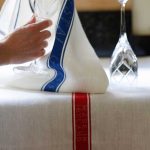Most people regard ironing as a chore. But ironing linen can become a less onerous task if you do it when the linen is damp. If linen is taken out of the dryer or off the line while still damp and then ironed immediately, the chore ceases to be a chore at all.
Be sure the soleplate of your iron is clean and smooth for quicker and easier ironing.
If you have a steam iron, check for mineral deposits, which can cause brown spotting.
Check your ironing board and its cover. For speedy ironing, use well padded boards with smooth heat-reflective covers.
Begin with dampened linen. Steam ironing dry linen is less effective than dry or steam ironing dampened linens. A professional steamer is the only appliance that provides enough steam to remove wrinkles from heavier linens. The steam from a household iron is just not enough.
Store linen items in a plastic bag in the refrigerator or freezer from 6 to 24 hours before ironing. This will make them easier to iron and will prevent mildew.
Use spray starch (if desired) and iron with a steam iron at a medium to hot setting. Starch provides extra crispness, particularly to napkins to be folded into fancy shapes. For a softer look, select spray-on fabric sizing instead. In a pinch, smooth things over with spray-on wrinkle remover.
Iron on the wrong side first, then on the right side to bring out the sheen, especially damasks and light-colored linens. Iron dark linens on the wrong side only.
Choose a temperature setting compatible with the fabric weight. Pure linen can withstand the highest temperature setting on your iron. Test an inconspicuous corner first.
Iron linen until smooth but not dry. Once wrinkles are gone, hang the linen item until it is bone dry.
When ironing embroidered linen, keep the embroidery stitches rounded and dimensional by pressing item on the wrong side atop a soft towel.
Use a press cloth to safeguard delicate lace and cutwork. A press cloth also helps to avoid press marks over seams, hems and pockets.
Place a table next to the ironing board when ironing large tablecloths. Roll finished sections of the cloth over the table rather than letting it pile up under the ironing board.
Minimize creasing ironed tablecloths by rolling them around a tube or hanging them.


